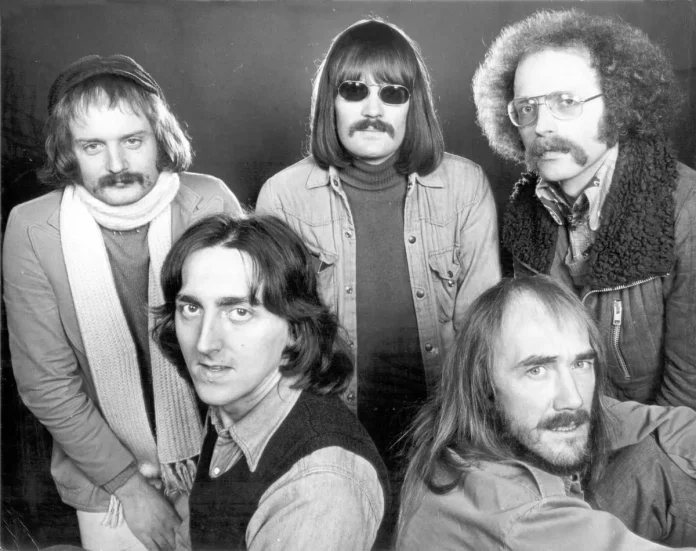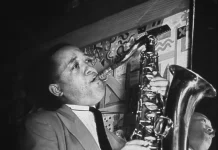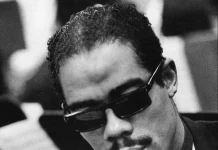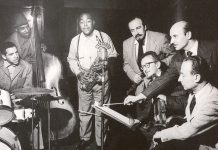
Jazz changes its features no less than the individuals who play it and listen to it. I was reminded of this on reading Nic Jones’s review of Penumbra II by Karl Jenkins, the Welshman’s previously unreleased 1971 recording by a 10-piece band including Ray Warleigh, Alan Skidmore and Chris Spedding. Nic believes it sounds fresher than some music made not six years ago.
It’s a moot point. The passage of half a century will result in change if not progress or improvement. When I was a student at Cardiff University, Jenkins was an undergraduate in its music department, then being revitalised under the professorship of Alun Hoddinott. I used to see Jenkins queueing for beans on toast in the students’ union canteen at Dumfries Place, in winter dressed in a long overcoat and a pork-pie hat, though not one as severe as Prez’s with its extra slice off the top.
Jenkins was a postgraduate student at the Royal Academy of Music. He emerged as a protégé of Graham Collier, helped to form Nucleus and joined Soft Machine, playing tenor and baritone sax as well as the oboe. Today, as Sir Karl, he’s the flamboyantly moustachioed composer of “accessible” music – a description he would probably dislike only for its connotations of disparagement – and “yn drysor cenedlaethol” (“a national treasure”, which is a label that looks less threadbare in Welsh).
Jenkins’ changes of outlook have been chameleon-like. Changes in a chameleon’s appearance bestow Darwinian advantage; it’s an alteration not an advance, and in his case not a deliberately peacock display. Jenkins’ changes of musical persona have been nothing less than interesting and he’s able to defend his music – and sometimes has to – in the context of what’s being written by a younger generation of Welsh composers fired by Continental exemplars and a totally different historical lineage.
Nic’s view illustrates how difficult it is to map the course of jazz history. The present is something that becomes the past in an instant but it must remain so for a while before it can be assessed as significant or not. From the viewpoint of the noughties, the significance of what happened in jazz in the 1930s and 1940s enjoys a consensus except among the obdurate. The seismic changes brought in by bebop are now mere rumbles in historical terms (but not in terms of the music’s essence; only its dilution by endless simulacra achieves that). Commentators cannot say jazz died out at some point with any more confidence than they can claim it’s going nowhere today. Change has a way of consolidating art rather than divorcing itself from its moving trajectory.
Who would dare estimate where jazz is headed based on the scores of albums reviewed monthly on this website? It’s enough to evaluate what’s on offer on its own terms, rarely on its merit as a contribution to the music’s development; it contributes by definition but the weight of its offering can only be estimated with time – unless you’re a critic of remarkable prescience, and that won’t be known till some future date.
Mention of Hoddinott reminds me of Kenneth Loveland, my first mentor as a classical-music critic. Loveland, a daily-newspaper editor, had been covering music in Wales when Hoddinott’s Clarinet Concerto made ripples at the Cheltenham Festival, an international event. He was there, pencil and notebook poised. Loveland was recruited by Frank Howes of the Times to monitor and write about what was happening in Wales, where Hoddinott and William Mathias had joined the older Daniel Jones and Grace Williams in a musical Cymraeg renaissance. To discover his accounts of opera productions at La Scala, Milan, in a British provincial newspaper (he repeated his Times reports for the publication he edited) always raised a smile at their incongruity.
Apart from reminding me that newspaper music criticism was a branch of journalism, not of musicology, Loveland also hated the term “classical music”. He used to say, if a definition were needed, that the music he was responsible for as a critic possessed a seriousness that instilled silence, propriety and rapt attention in the listener. This was a useful definition in excluding dance music and, today, helps to distinguish amplified rock music played to noisy, mobile-toting multitudes. A dabbler on the drum kit when younger, he was interested in how jazz changed from music for dancing to music for listening; and the corollary of that: how jazz tropes and improvisation had been commandeered by “serious” composers because audiences listen to them. (Interesting to note how many bands at jazz-club gigs encourage the audience to rouse itself from what must seem like uncharacteristic torpor to bust a groove. Some respond.)
Loveland always exhorted me to write with authority – or, to be cynical, with the impression (rather than the pretence) of authority. History needs authorities. As Gary Giddins says in the 2004 introduction to Weather Bird: Jazz At The Dawn Of Its Second Century, in which he laments the disappearance of jazz from American commercial TV and radio: “A vigorous art deserves and requires a disputatious criticism. Better to be wrongheaded and punitive from time to time than reliably soft, predictable, and accommodating.” Part one of Giddins’ book covers jazz he reviewed from 1990 to 2000, a period he called The Beige Decade. Beige, as he knew, was not so much a colour, more a coded hue for neutrality, or lack of purpose.
No-one knows where jazz is going. But the only reason any history of jazz exists is that historians make connections that link, say, Freddie Keppard with Cecil Taylor and Rudresh Mahanthappa. At the same time, certain musicians may not wish to be fettered with the label jazz. In fact, one told me at a jazz-club gig last year that she was only there because she couldn’t think of any other specialised venue that would book her and, in any case, she loved jazz and it inspired her. Giddins himself declined to use the word “jazz” in the title of the column he wrote for the Village Voice for almost 14 years because “music” and “jazz” had become mutually exclusive. The title he chose, Weather Bird, referred to the famous Louis Armstrong-Earl Hines duet, which was never anything other than a jazz classic. To the UK media, unpredicated “music” means pop and rock.
No doubt Sir Karl Jenkins doesn’t mind his time with Soft Machine and Nucleus being subsumed as jazz under the umbrella of music and he may feel that the inspiration for the different genres he’s worked in has the same source. At the end of the 1966 edition of A Pictorial History Of Jazz, Orrin Keepnews (who’d written it with Bill Grauer Jr in the 1950s), hoped that jazz could move forward without losing contact with its own past. “But with or without remembrance of the past, inevitably jazz has changed, does change, will change again,” he said.
Ah, the past – to many, it’s another country. How will we identify what it actually is that’s changing? The music Karl Jenkins et al made 50 years ago may well have been better than anything heard in the UK since 2016. Only history will judge.














